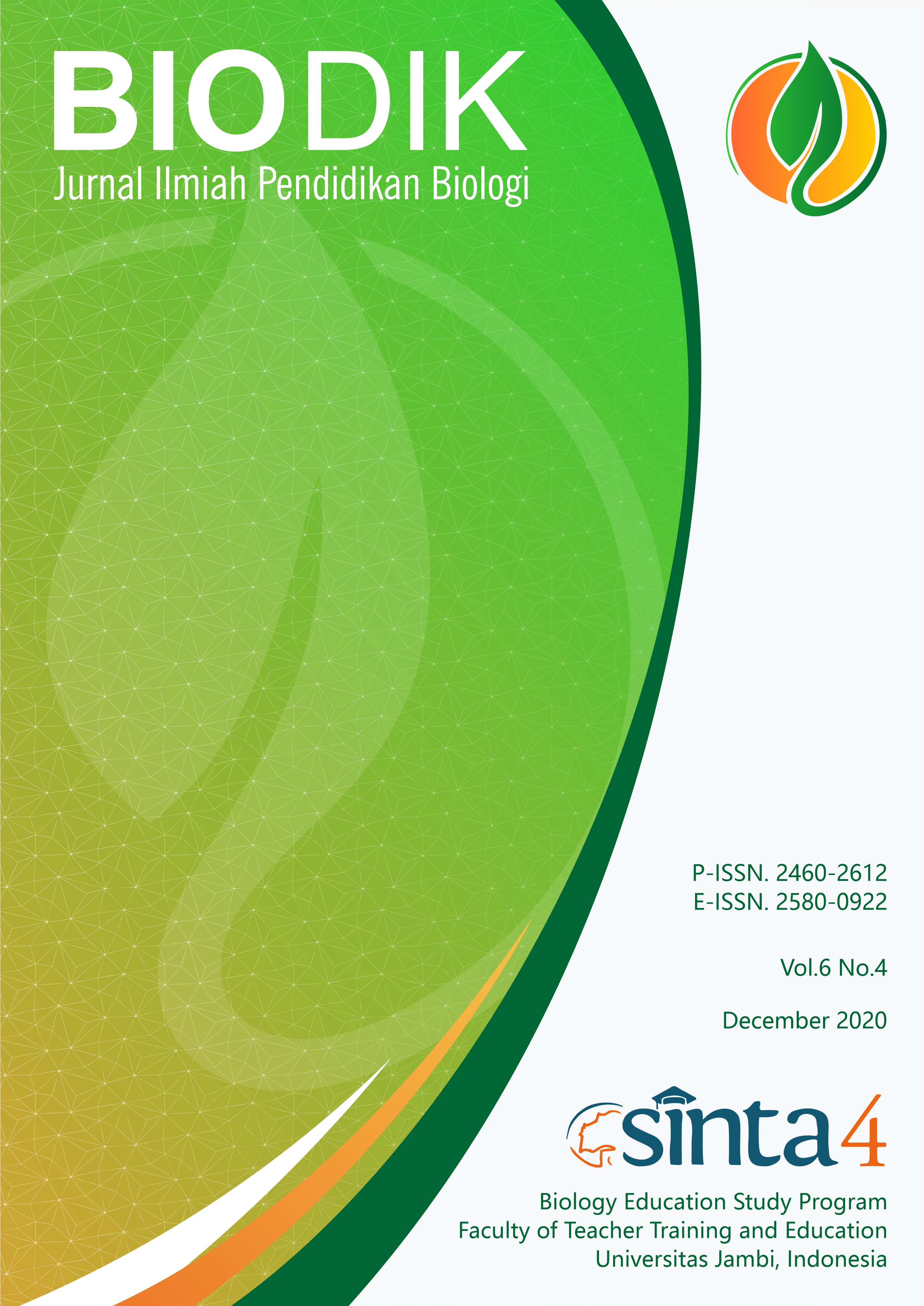Analisis Kualitas Struktur Pada Lembar Kegiatan Siswa (LKS)
DOI:
https://doi.org/10.22437/bio.v6i4.9465Abstract
This study aims to determine the completeness structure and quality of worksheets, based on Vee diagram and describe the results of the analysis. In addition, the purpose of this study describes the reconstruction towards the Student Worksheet based on the objectives, practicum process and questions that form the basis of this study. This research is a qualitative descriptive study with total sampling technique. The subjects were 10 worksheets contained in the biology textbook class XI food test material. The result of analysis the Student Worksheet found confusing work steps, the amount of food used, recording data not in accordance with the work steps carried out, repetition of tests with known contents, determination of practicum time, errors in each test could not be avoided if practicum less thorough, and discoloration that is not according to the expected procedure. In general, student worksheet of Food Test refers to instruments based on Vee Diagrams which analyze the conceptual, procedural, and knowledge construction aspects. The results of Vee diagram component analysis on 10 worksheets that appeared were focus questions, objects / events, as well as theories / principles / concepts, while the record / transformation component, and claim knowledge had not yet appeared. On average, 10 student worksheets analyzed didn’t form an ideal claim knowledge, however the construction of the student worksheet knowledge could be improved.
Downloads
References
Abraham, I. (2009). Does practical work really motivate? A study of the affective value of practical work in secondary school science. International Journal of Science Education. 31 (17), 2335-2352. https://doi.org/10.1080/09500690802342836.
Alvarez & Risko. (2007). The Use Of Vee Diagrams With Third Graders As A Metcognitive Tool For Learning Science Concepts. Departmen of Teaching and Learning Presentations: Tennessee State University.
Aris, F. (2014). Kelayakan Teoritis Lembar Kegiatan Siswa Berbasis Pemecahan Masalah pada Materi Pengolahan Limbah. Jurnal Bioedu Berkala Ilmiah Pendidikan Biologi, 3(3), 431-436. BSNP. (2006), Panduan Penyusunan Kurikulum Tingkat Satuan Pendidikan Jenjang Pendidikan Dasar dan Menengah, BSNP Jakarta.
Dahar, R.W. (2011) Teori-teori Belajar. Jakarta: Erlangga.
Hofsten, A. & Lunetta, V.N. (2004). The Laboratory in Science Education: Foundation for the Twenty first Century. Science Education, 88, 28-54.
Laelasari,Iseu & Supriatno, B. (2018). Analisis Komponen Penyusun Desain Kegiatan Laboratorium Bioteknologi. Jurnal Bioedukatika Universitas Ahmad Dahlan, Vol.6, Nomor 2, hal. 84-90.
Liliasari, (2011). Membangun Masyarakat Melek Sains Berkarakter Bangsa Melalui Pembelajaran. [Makalah] Seminar Nasional UNES Semarang.
Novak & Gowin. (1984) Learning How to Laearn. New York: Cambridge University Press.
Ramadhayanti, et al. (2020). Analisis Kualitas Struktur dan keberadaan Literasi Kuantitatif pada Lembar Kerja Peserta Didik Biologi SMA. [Skripsi] Departemen Pendidikan Biologi FPMIPA Universitas Pendidikan Indonesia, 25-33.
Rohaeti, E. Widjayanti, E & Padmaningrum, R.T. (2006). Pengembangan Lembar Kerja Peserta Didik (LKS) mata pelajaran sains kimia untuk SMP kelas VII, VIII,dan IX. Yogyakarta: Jurusan Pendidikan Kimia FPMIPA UNY.
Situmorang, et al. (2019). Pengembangan Lembar Kerja Siswa (lks) Berbasis Inkuiri Terbimbing Pada sub Materi Uji Kandungan Zat Makanan. Jurnal Pelita Pendidikan, 7(1), 023-027.
Supriatno, B. (2009). Uji Langkah Kerja Laboratorium Sekolah. Proseding Seminar Nasional Biologi: Inovasi dan pendidikan Biologi dalam Pengembangan Sumber Daya Manusia, 255-261.
Supriatno, B. (2013). Pengembangan Program Perkuliahan Pengembangan Praktikum Biologi Sekolah Berbasis ANCORB untuk Mengembangkan Kemampuan Merancang dan Mengembangkan Desain Kegiatan Laboratorium. Disertasi Jurusan Pendidikan Biologi FPMIPA UPI: Tidak diterbitkan.
Suryaningsih, Yeni. (2017). Pembelajaran Berbasis Praktikum Sebagai Sarana Siswa untuk Berlatih Menerapkan Keterampilan Proses Sains dalam Materi Biologi. Program Studi Pendidikan Biologi Universitas Majalengka, 2(2), 49-57.
Trinanada, Winda. S. (2015). Analisis Struktur dan Kemungkinan Kemunculan Tingkat Kognitif pada Desain Kegiatan Laboratorium Materi Sel. [Skripsi] Departemen Pendidikan Biologi FPMIPA Universitas Pendidikan Indonesia.
Wahidah, Nur Sopiah, Bambang S, Kusumastuti M.N. (2018). Analisis Struktur dan Kemunculan Tingkat Kognitif pada Desain Kegiatan Laboratorium Materi Fotosintesis.
Widodo, A & Ramadhaningsih, V. (2006). Analisis Kegiatan Praktikum Biologi dengan Menggunakan Video. Metalogika. 9(2), 146-158.
Downloads
Published
Versions
- 2020-12-07 (4)
- 2020-12-18 (3)
- 2020-12-07 (2)
- 2020-12-07 (1)
How to Cite
Issue
Section
License
Copyright (c) 2020 Silvia Sukma Putri, Bambang Supriatno, Sri Anggraeni

This work is licensed under a Creative Commons Attribution-NonCommercial-ShareAlike 4.0 International License.
Copyright Notice
Authors who publish with Biodik : Jurnal Ilmiah Pendidikan Biologi agree to the following terms:
- For all articles published in Biodik : Jurnal Ilmiah Pendidikan Biologi, copyright is retained by the authors and grant the journal right of first publication with the work simultaneously licensed under a Creative Commons Attribution-ShareAlike 4.0 International Licensethat allows others to share the work with an acknowledgment of the work's authorship and initial publication in this journal.
- Authors are able to enter into separate, additional contractual arrangements for the non-exclusive distribution of the journal's published version of the work (e.g., post it to an institutional repository or publish it in a book), with an acknowledgment of its initial publication in this journal.
- Authors are permitted and encouraged to post their work online (e.g., in institutional repositories or on their website) prior to and during the submission process, as it can lead to productive exchanges, as well as earlier and greater citation of published work (See The Effect of Open Access).

















